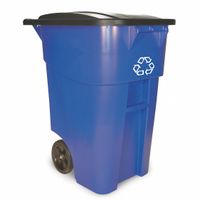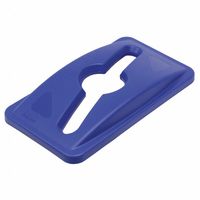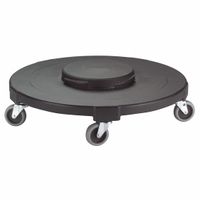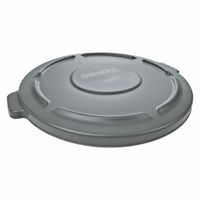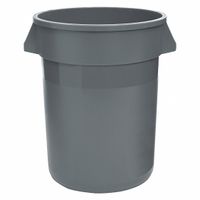Call +(254) 703 030 000 / 751 483 999 / 721 704 777
- Home
- Cleaning And Janitorial
- Waste Recycling Trash Supplies
- Trash Recycling Containers Accessories
.....Read More
Frequently Asked Questions
What size trash can do I need for my home or office?
To determine the appropriate size trash can for your home or office, consider the following factors:
1. **Location and Usage**:
- **Kitchen**: Typically requires a larger can, around 12-16 gallons, due to high waste volume.
- **Bathroom**: A smaller can, about 2-4 gallons, is sufficient for minimal waste.
- **Office**: A medium-sized can, around 7-10 gallons, works well for paper and small waste.
2. **Household or Office Size**:
- **Small Household/Office**: A 10-13 gallon can is generally adequate.
- **Large Household/Office**: Consider a 20-30 gallon can to accommodate more waste.
3. **Frequency of Trash Disposal**:
- If you dispose of trash daily, a smaller can may suffice.
- For less frequent disposal, opt for a larger can to prevent overflow.
4. **Recycling Needs**:
- If you separate recyclables, you may need additional bins, reducing the size needed for regular trash.
5. **Space Availability**:
- Ensure the can fits comfortably in the designated area without obstructing movement.
6. **Aesthetic and Design Preferences**:
- Choose a design that complements your decor, whether it’s a sleek stainless steel model or a simple plastic bin.
7. **Special Requirements**:
- Consider features like lids for odor control, foot pedals for hands-free use, or dual compartments for sorting waste.
By evaluating these factors, you can select a trash can that meets your specific needs, ensuring efficient waste management in your home or office.
How do I choose the right recycling container for my needs?
To choose the right recycling container, consider the following factors:
1. **Material Type**: Identify the types of materials you need to recycle (e.g., paper, plastic, glass, metal). Some containers are designed for specific materials, while others are multi-purpose.
2. **Capacity**: Assess the volume of recyclables you generate. Choose a container size that accommodates your needs without requiring frequent emptying.
3. **Space Availability**: Evaluate the space where the container will be placed. Ensure it fits comfortably without obstructing movement or access.
4. **Indoor vs. Outdoor Use**: Determine if the container will be used indoors or outdoors. Outdoor containers should be weather-resistant and durable.
5. **Design and Features**: Look for features like lids to contain odors, wheels for mobility, and color-coding or labels for easy sorting.
6. **Ease of Use**: Consider containers with ergonomic designs for easy handling and emptying. Ensure they are user-friendly for all potential users.
7. **Aesthetics**: If aesthetics are important, choose a container that complements the environment, especially in public or office spaces.
8. **Budget**: Set a budget and find a container that meets your needs without exceeding it. Consider long-term savings from durable, high-quality options.
9. **Regulations and Guidelines**: Check local recycling guidelines and regulations to ensure compliance with container requirements.
10. **Sustainability**: Opt for containers made from recycled materials or those that are recyclable themselves to enhance sustainability efforts.
By considering these factors, you can select a recycling container that effectively meets your needs and supports your recycling goals.
What materials are trash and recycling containers made from?
Trash and recycling containers are made from a variety of materials, each chosen for its durability, cost-effectiveness, and suitability for the intended use. Common materials include:
1. **Plastic**: High-density polyethylene (HDPE) and polypropylene are popular choices for both trash and recycling bins due to their lightweight nature, resistance to impact, and ability to withstand harsh weather conditions. These plastics are often used for residential curbside bins and smaller indoor containers.
2. **Metal**: Steel and aluminum are frequently used for commercial and public space containers. Steel is valued for its strength and durability, making it ideal for high-traffic areas. Aluminum, being lighter and resistant to rust, is often used for recycling bins, especially in outdoor settings.
3. **Fiberglass**: This material is used for its strength and resistance to corrosion and weathering. Fiberglass containers are often found in industrial settings or areas where exposure to harsh elements is a concern.
4. **Wood**: Though less common, wood is sometimes used for decorative or specialty containers, particularly in parks or natural settings where aesthetics are important. These containers are often lined with metal or plastic to improve durability.
5. **Concrete**: Used primarily for outdoor public spaces, concrete containers are extremely durable and resistant to vandalism. They are heavy, which prevents them from being easily moved or tipped over.
6. **Composite Materials**: Some containers are made from a combination of recycled plastics and wood fibers, offering a sustainable option that is both durable and environmentally friendly.
Each material offers distinct advantages and is selected based on factors such as location, expected usage, and environmental considerations.
How can I prevent odors from trash cans?
To prevent odors from trash cans, start by choosing a trash can with a tight-fitting lid to contain smells. Line the can with a durable trash bag to prevent leaks. Regularly clean the trash can with a mixture of water and vinegar or baking soda to eliminate lingering odors. Sprinkle baking soda or place a charcoal odor absorber at the bottom of the can to neutralize smells. Dispose of trash frequently, especially food waste, to prevent decomposition and odor buildup. Consider using scented trash bags or adding a few drops of essential oils to the bag for a pleasant aroma. Segregate waste by composting organic material separately to reduce odor in the main trash can. Ensure the trash can is dry before placing a new bag to prevent mold and bacteria growth. If possible, store the trash can in a well-ventilated area to allow odors to dissipate.
Are there specific trash cans for outdoor use?
Yes, there are specific trash cans designed for outdoor use. These outdoor trash cans are built to withstand various weather conditions, resist pests, and accommodate larger volumes of waste. They are typically made from durable materials such as heavy-duty plastic, metal, or concrete to ensure longevity and stability.
Outdoor trash cans often feature secure lids to prevent animals from accessing the contents and to minimize odors. Some models include locking mechanisms for added security. They may also have ventilation systems to reduce moisture buildup and prevent unpleasant smells.
Designs vary to suit different environments, such as parks, streets, or residential areas. For instance, public spaces might use large-capacity bins with easy access for maintenance crews, while residential areas might prefer more aesthetically pleasing designs that blend with the surroundings.
Additionally, outdoor trash cans can be equipped with features like wheels for mobility, foot pedals for hands-free operation, and compartments for recycling. Some are designed to be anchored to the ground to prevent tipping or theft.
Overall, outdoor trash cans are essential for maintaining cleanliness and hygiene in public and private outdoor spaces, and their design reflects the specific needs of the environment in which they are used.
How do I properly clean and maintain trash containers?
To properly clean and maintain trash containers, follow these steps:
1. **Regular Emptying**: Empty the trash container frequently to prevent odors and pest attraction.
2. **Initial Rinse**: After emptying, rinse the container with a hose to remove loose debris.
3. **Cleaning Solution**: Use a mixture of water and a mild detergent or a solution of water and vinegar. For stronger cleaning, add baking soda or use a commercial cleaner.
4. **Scrubbing**: Use a long-handled brush to scrub the interior and exterior of the container. Pay special attention to corners and the bottom where grime accumulates.
5. **Rinse Thoroughly**: Rinse the container thoroughly with water to remove all soap or cleaning solution residues.
6. **Disinfecting**: Apply a disinfectant spray or a bleach solution (1 part bleach to 9 parts water) to sanitize the container. Let it sit for a few minutes before rinsing again.
7. **Drying**: Allow the container to air dry completely in the sun, which also helps to eliminate odors and bacteria.
8. **Odor Control**: Sprinkle baking soda at the bottom of the container to absorb odors. Alternatively, use charcoal briquettes or commercial odor absorbers.
9. **Liner Use**: Use trash bags or liners to minimize direct contact with waste, making cleaning easier.
10. **Regular Maintenance**: Inspect the container for cracks or damage regularly. Replace if necessary to prevent leaks and pest entry.
11. **Location**: Store the container in a shaded, well-ventilated area to reduce odor buildup and prevent material degradation from sunlight.
12. **Pest Prevention**: Ensure lids fit tightly and consider using bungee cords or clips to secure them against animals.
By following these steps, you can maintain a clean, odor-free, and durable trash container.
What accessories are available to make trash and recycling collection easier?
To make trash and recycling collection more efficient and convenient, a variety of accessories are available:
1. **Trash Can Liners**: Heavy-duty liners prevent leaks and make it easier to remove waste without spills.
2. **Lid Locks and Clips**: These keep lids secure, preventing animals from accessing the contents and reducing spillage during windy conditions.
3. **Wheeled Carts**: Adding wheels to trash cans or using wheeled carts makes it easier to transport heavy loads to the curb.
4. **Handle Grips**: Ergonomic grips can be attached to trash can handles to improve comfort and control when moving bins.
5. **Bag Holders**: These devices keep trash bags open and in place, making it easier to fill them without the bag collapsing.
6. **Compost Bins**: For organic waste, compost bins can be used to separate and process biodegradable materials, reducing overall waste.
7. **Recycling Bin Labels**: Clear labels help in sorting recyclables correctly, ensuring compliance with local recycling guidelines.
8. **Trash Can Enclosures**: These structures hide unsightly bins and protect them from weather and animals.
9. **Odor Control Products**: Deodorizers and charcoal filters can be placed in bins to minimize unpleasant smells.
10. **Bin Liners**: Reusable liners for recycling bins help in keeping them clean and make it easier to transport recyclables.
11. **Trash Compactors**: These reduce the volume of waste, allowing more to fit in a single bin and reducing the frequency of collection.
12. **Smart Sensors**: These devices alert when bins are full, optimizing collection schedules and reducing unnecessary trips.
13. **Bin Organizers**: Racks or dividers can be used to organize different types of recyclables within a single bin.
14. **Curbside Collection Signs**: These indicate collection days and help ensure bins are placed out on time.
These accessories enhance the efficiency, cleanliness, and convenience of waste management processes.
